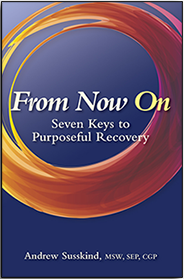This is one of my favorite charts because it captures two possible directions: 1. Leaning into love and intimacy or 2. Repeating past painful patterns that were established in childhood. Here are some of the differences between authentic intimacy and pseudo-intimacy:
| Authentic Intimacy | Pseudo-Intimacy |
| Develops after we feel secure. | Tries to create love even though we feel frightened and insecure. |
| Comes from feeling full. | Always trying to fill an inner void. |
| Begins with loving ourselves — being the lover we think we need. | Tries to avoid looking at ourselves and always seeks to get love from that special someone. |
| Based on our ability to love and trust ourselves and hence others. | Seeks sex and romance outside, precisely because we feel empty inside and don’t trust ourselves or others. |
| Allows us to be vulnerable because we feel secure inside. | Based on a shaky foundation—we feel we must protect ourselves. |
| Grows slowly, like a tree. | Grows fast, as if by magic. |
| Thrives on time alone as well as time with our partner. | Frightened of being alone. |
| Teaches me to value my own company. | Makes me feel uncomfortable with myself and in need of someone else. |
| Gentle and comfortable. | Tense and combative. |
| Flows out. | Caves in. |
| Creates a deeper sense of ourselves the longer we’re together. | Creates a loss of self the longer we’re together. |
| Gets easier as time goes on. | Requires more effort as time goes on. |
| Like rowing across a gentle lake. | Like being swept down a raging river. |
| Satisfied with the partner we have. | Always looking for more or better. |
| Teaches that we can only make ourselves happy. | Expects the other person to make us happy and demands that we try and make them happy. |
| Creates life. | Creates drama. |
Action Steps:
- Lean into safe, loving relationships. Become the pursuer rather the distancer. Who would you like to pursue as a friend or confidant? Consider your options and choose someone you would like to pursue.
- Be a giver of love even if that’s scary. Notice when love shows up in front of you and take note of how it feels. Track loving moments—both giving and receiving love from others.
- Learn from your pets. They are instinctive teachers of unconditional love, acceptance, and play. Pay attention to their acceptance. Savor. If you don’t have a pet, consider fostering one or volunteering at your local shelter.
- Take inventory of the most intimate friendships in your life. Write a list of past relationships that have been the most meaningful. Identify their commonalities.
- Notice when you feel trust and relaxation in relationships. Without these qualities, intimacy does not exist. Be mindful when you’re feeling more relaxed with others. Take note of what happens inside you and how it indicates deepening trust.
- Identify your people and cultivate deeper contact through vulnerability and emotional risk-taking. Be the reliable person you would like to find in others. Consider small emotional risks and show up wholeheartedly for relationships, one intimate moment at a time.
Love is an action and a practice, and most of us resist it as much as we long for it. Observe yourself with curiosity and non-judgment and see how things unfold.




